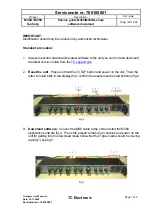GD32A50x User Manual
611
Loopback and silent mode
To enter this mode, set the LSCMOD bit in CAN_CTL1 register to 1. In this mode, the
messages are internally transmitted back to the receiver input, and the bit sent during the
ACK slot in the frame acknowledge field is ignored to ensure reception transmitted by itself.
Both transmit and receive interrupts are generated.
Loopback and silent mode is used for self-test. The Rx pin is ignored and the Tx pin holds in
recessive state.
Monitor mode
To enter this mode, set MMOD bit in CAN_CTL1 register to 1.
When Monitor mode is entered, ERRSI[1:0] bit field in CAN_ERR1 register is set to 0b01 by
CAN to indicate that the module works in an Error Passive state. In this mode, error counters
are frozen for transmission and reception.
In Monitor mode, no transmission is performed and reception is performed only when
messages are acknowledged by other CAN nodes, detection of a message that has not been
acknowledged will lead to a bit dominant error flag (without changing the RECNT[7:0] or
REFCNT[7:0] in CAN_ERR0 register).
23.3.4.
Power saving modes
The CAN interface has two power saving modes:
CAN_Disable mode.
Pretended Networking mode.
In these two power saving modes, the dedicated RAM and the registers in SRAM can not be
accessed.
CAN_Disable mode
The CAN module is enabled or disabled by configuring the CANDIS bit in CAN_CTL0 register.
For power saving, if CANDIS bit is set to 1 to disable CAN module, the CAN module will enter
CAN_Disable mode after a delay when the LPS bit and NRDY bit in CAN_CTL0 register are
changed to 1.
When CAN is disabled, the clocks to the Protocol controller and the Controller Interface are
disabled. All registers except the CAN_RMPUBF, CAN_RFIFOPUBF, CAN_RFIFOIFMN,
and CAN_RFIFOMPFx (x=0..31) registers are accessible. Also the dedicated RAM can not
be accessed.
After CAN is enabled, you need to dalay a time to wait for LPS bit in CAN_CTL0 register to
be cleared for Protocol controller recognization. When CAN is enabled, CAN module requests
to resume the clocks to the Protocol controller and the Controller Interface.

















